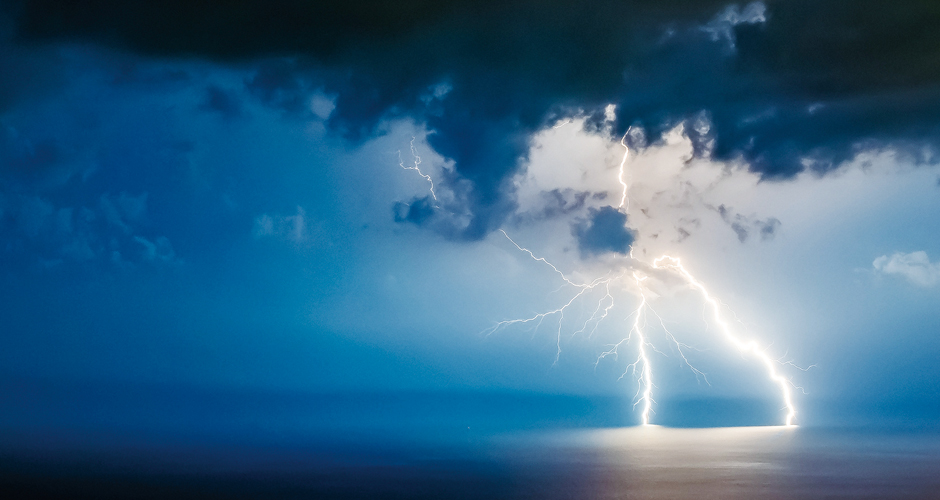 17th December 2020
17th December 2020
For many years seafarers have battled the elements on the oceans of the world with uncertainty and life threatening weather conditions, now help is at hand as advanced technology is providing customised weather information directly to the bridge of thousands of ships to enhance the safety of lives at sea.
As the world of shipping moves to reduce CO2 emission, there is also a growing need to mitigate the associated weather risks facing ships and crew at sea.
Now there are a number of digital platforms that deliver real-time information to ships at sea, providing advance warnings about typhoons, hurricanes, storm surges and strong currents.
One such company is StormGeo which provides voyage and vessel performance information, providing the crew with granular local weather reports and forecasts to enable joint decisions made by bridge officers and shoreside experts.
“For the route planning part there is clearly an interest for one platform providing as much information as possible for the process of voyage planning which includes appraisal, planning, execution and monitoring. This relates to all charts and nautical publications for the route planning itself and extends to legal and safety regulations
to be carried on board,” said Dennis Thielsen, Vice President, Planning & Navigation of StormGeo Shipping.
“Optimising a route is a natural part of the planning process. Software and Service solutions like s-Suite include functionalities to optimise routes with focus on reduced fuel consumption and safety for crew, ship and cargo. Especially the possible fuel savings and reduced CO2 emissions are a driver for interest in such solutions.”
Before digital route planning and real time weather information was available to commercial ships, masters and crew had to rely on historical data and radio reports broadcast by littoral states along the way. Often the information would be hours delayed, leaving little time to change course or call into a port in the event of a storm.
Paper navigation charts are also still widely used on board ships, despite the introduction of Electronic Navigational Charts (ENCs), which are connected to an International Maritime Organization (IMO) approved Electronic Chart Display and Information System (ECDIS). The charts combine the data from all of the world’s coastal countries mapping coastlines, water depth, sandbanks, approach channels, underwater obstructions and currents.
As ENCs are more widely used they can also be integrated with voyage optimisation and planning systems so Masters have ocean, weather and local navigation data available to react and make the right decisions with real time information.
There are many variables involved in optimal route planning through adverse weather conditions such as the type of vessel and also the kind of cargo it is carrying. Vessel specifications such as age, stability and speed are all analysed before recommendations are made to captains and fleet managers.
One of the key factors is how to sail the optimal route at minimal cost and how to arrive at a fixed time or to achieve the required Estimated Time of Arrival (ETA).
Specialist route analysts also consider sea temperature, winds, swell, and ice as well as numerous other factors in their evaluation of each vessel and each specific voyage.
The data regarding the performance the voyage and the ship are then included in a Return on Investment (ROI) report at the end of each voyage. The ROI includes a Route Advisory Service that during a specific period of time, helps to optimise savings related to fuel and time, as well as vessel deficiencies.
The Master of a Pacific handymax intended to sail along a great-circle course from San Francisco to Tsugaru Kaikyo, the strait which separates the Japanese islands of Hokkaido and Honshu. Much of the Pacific at the time of sail (mid-March) was covered in westerly swells in excess of 6 metres, similar to the Atlantic in December. Had the Master proceeded along the intended route, the vessel would have been exposed to prolonged winds and seas on its bow, with periods of storm force winds and swells nearing 10 metres.
Instead, StormGeo Route Analysts recommended a route north from the Gulf of Alaska into the Bering Sea. This optimised route allowed the vessel to be aided by easterly conditions and stay north of heavy westerlies generated by several storms that were tracking west to east at the time.
Equipped with the onboard route optimisation software s-Planner | BVS, the captain of the handymax could visualise and validate the recommendation made by StormGeo’s Route Analysts. StormGeo’s route saved the vessel 38.4 Metric Tons of fuel and $16,937 when compared to the Master’s originally intended route and helped the Master arrive in Japan safe and sound.
In the freight business we are also aware that delays caused by late arrivals at port can have expensive consequences through insurance claims or litigation for breach of contract. The freight insurance companies and P&I Clubs (that insure the hull and machinery of the vessels) are supporting the investment in onboard weather related digital solutions. From an insurance perspective anything that mitigates the risk of crew, ship or cargo damage is to be welcomed.
The dramatically changing weather patterns we are seeing across the world means that captains of vessel have less time than ever to react, respond and avoid potential risk to life damage to the vessel or lost and damaged cargo.
Advance customised forecasts per ship for each voyage will help the captain and fleet managers make informed decisions that prioritise safety, security and vessel integrity as well as enabling the optimum speed and route plan to minimise delays.
From an environmental perspective utilising voyage planning to avoid adverse weather, high waves and strong currents means that less fuel will be burned reducing emissions. More importantly many catastrophic casualties will also be avoided, avoiding loss of life and pollution of the oceans.